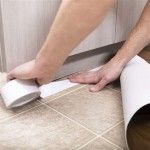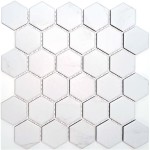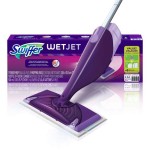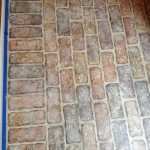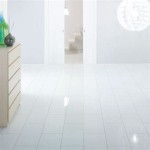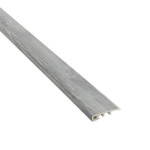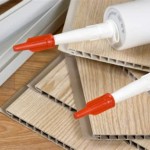What To Put On Chair Legs To Protect Hardwood Floors
Hardwood floors are a desirable feature in many homes, admired for their beauty, durability, and classic appeal. However, they are susceptible to scratches, dents, and other damage from furniture, particularly chair legs. Understanding the options available for protecting hardwood floors from chair leg damage is crucial for maintaining their longevity and aesthetic value. Choosing the appropriate protection requires consideration of factors such as the type of chair, the frequency of use, and the desired aesthetic.
This article explores the various types of protective measures that can be applied to chair legs to safeguard hardwood floors, detailing their advantages, disadvantages, and appropriate applications. Implementing these safeguards can significantly reduce the risk of damage, preserving the pristine condition of hardwood floors for years to come.
Felt Pads: A Common and Versatile Solution
Felt pads are a widely popular and readily available solution for protecting hardwood floors from chair legs. They are typically made from a dense, compressed felt material with an adhesive backing, allowing them to be easily attached to the bottom of chair legs. Felt pads work by creating a soft barrier between the chair leg and the floor, preventing direct contact and reducing the risk of scratching as the chair is moved.
The primary advantage of felt pads is their affordability and ease of installation. They are relatively inexpensive and can be quickly applied by simply peeling off the backing and sticking them onto the chair legs. Felt pads are also available in a variety of shapes and sizes, accommodating different chair leg dimensions. Furthermore, they are typically discreet and blend in well with most chair styles.
However, felt pads have several limitations. Their adhesive backing can sometimes fail, causing the pads to detach and potentially leave sticky residue on the floor. They also tend to collect dirt, dust, and debris, which can negate their protective effect and actually contribute to scratching. Regular cleaning or replacement of felt pads is necessary to maintain their effectiveness. Another drawback is their tendency to wear down over time, especially with frequent use on rough or uneven surfaces. Consequently, felt pads are best suited for chairs that are not moved frequently or for floors that are regularly cleaned.
Felt pads are available in various thicknesses. Thicker pads offer greater cushioning and protection, while thinner pads are less noticeable. The choice of thickness depends on the weight of the chair and the level of floor protection desired. Selecting high-quality felt pads with strong adhesive and a durable felt material is essential for maximizing their lifespan and effectiveness.
When applying felt pads, it is important to clean the chair legs thoroughly to remove any dirt or debris. This ensures proper adhesion and prevents the pads from detaching prematurely. The pads should be centered on the bottom of the chair legs and pressed firmly to secure them in place. Regularly inspect the pads and replace them as needed to maintain optimal floor protection.
Rubber Caps and Furniture Socks: Durable and Protective Options
Rubber caps and furniture socks offer a more durable and long-lasting alternative to felt pads. Rubber caps are typically made from a flexible rubber material that encases the bottom of the chair leg, providing a secure and cushioned barrier. Furniture socks, on the other hand, are knitted sleeves that slip over the chair legs, offering a softer and more aesthetic solution.
Rubber caps are known for their durability and resistance to wear and tear. They are less likely to detach than felt pads and provide a more robust level of protection against scratches and dents. Rubber caps are also waterproof and easy to clean, making them suitable for use in areas prone to spills or moisture. They are especially effective for chairs that are frequently moved or used on rough surfaces.
However, rubber caps can be more expensive than felt pads and may not be as aesthetically pleasing. They are also more difficult to install, requiring a precise fit to ensure they stay securely in place. Choosing the correct size of rubber cap is crucial for optimal performance. If the cap is too small, it will be difficult to install and may not provide adequate protection. If the cap is too large, it will be loose and may slip off easily.
Furniture socks offer a softer and more decorative alternative to rubber caps. They are available in a variety of colors and patterns, allowing them to be coordinated with the chair and room decor. Furniture socks are also easy to install, simply slipping over the chair legs. They provide a cushioned barrier that protects the floor from scratches and dents. Furthermore, they can be easily removed and washed, making them a hygienic option.
The main disadvantage of furniture socks is their susceptibility to wear and tear. They can become frayed or torn with frequent use, requiring regular replacement. They may also not provide as much protection as rubber caps, especially on rough surfaces. Furniture socks are best suited for chairs that are not moved frequently or for floors that are relatively smooth.
When selecting rubber caps or furniture socks, it is important to consider the shape and size of the chair legs. Measure the diameter or circumference of the chair legs to ensure a proper fit. Look for high-quality materials that are durable and resistant to wear and tear. Regularly inspect the caps or socks and replace them as needed to maintain optimal floor protection.
Casters and Glides: The Choice for Movable Furniture
For chairs and other furniture that are frequently moved, casters and glides provide a more practical and convenient solution for protecting hardwood floors. Casters are wheels that are attached to the bottom of the chair legs, allowing the chair to be easily rolled across the floor. Glides are smooth, low-friction surfaces that allow the chair to slide smoothly without scratching the floor.
Casters offer the advantage of effortless mobility. They make it easy to move chairs around the room without lifting them, reducing the risk of damaging the floor or straining oneself. Casters are particularly useful for office chairs or dining chairs that are frequently moved in and out from under a table.
However, not all casters are suitable for hardwood floors. Hard plastic casters can scratch and damage the floor surface. Soft rubber or polyurethane casters are preferred, as they provide a cushioned and non-marring surface. The size and type of caster also affect its performance. Larger casters roll more easily and distribute the weight of the chair more evenly, reducing the risk of dents or impressions. Ball bearing casters provide smoother and quieter operation.
Glides offer a less conspicuous alternative to casters. They are typically made from nylon, Teflon, or other low-friction materials. Glides allow the chair to slide smoothly across the floor without lifting it, protecting the floor from scratches and scuffs. Glides are also available in a variety of shapes and sizes, accommodating different chair leg dimensions.
The main disadvantage of glides is that they require more effort to move the chair compared to casters. They are best suited for chairs that are only occasionally moved. Glides can also collect dirt and debris, which can negate their protective effect. Regular cleaning or replacement of glides is necessary to maintain their effectiveness.
When selecting casters or glides, it is important to consider the type of flooring and the intended use of the chair. Soft rubber or polyurethane casters are recommended for hardwood floors. Choose a caster size that is appropriate for the weight of the chair and the type of flooring. Ensure that the casters or glides are properly installed and regularly inspected to prevent damage to the floor.
The installation method for both casters and glides depends on the chair's design. Some chairs have sockets designed to accept stemmed casters, while others may require a mounting plate to attach to the chair leg. Glides often require hammering into the chair leg or attaching with screws.
Beyond these specific solutions, maintaining cleanliness of the floor is essential for minimizing damage. Regularly sweeping or vacuuming keeps abrasive debris from accumulating and being pressed into the floor by furniture legs, no matter what protective measure is being used. Using floor mats underneath chairs in high-traffic areas can also significantly reduce wear and tear.

32pcs Silicone Chair Leg Protectors Anti Scratch Caps For Hardwood Floors Com
Felt Leg Protectors

24 Pcs Chair Leg Floor Protectors For Hardwood Floors Felt Furniture Pads Table Caps Covers Bar Stool

Top 6 Best Chair Leg Floor Protectors For Carpet Tile Wood Vinyl Hardwood Floors Review 2024

Small Rectangle Silicone Chair Leg Caps With Felt Pads 24pcs Rectangular Clear Floor Protectors For Hardwood Floors Covers To

Small Rectangle Silicone Chair Leg Caps With Felt Pads 8pcs Rectangular Floor Protectors For Hardwood Floors Covers To Protect

Chair Legs Protect Wood Floors Everbilt 1 4 Clear Rubber Like Plastic Leg Caps For Table

What Are The Best Options For Plastic Covers On Table Or Chair Legs Artisan Wood Floors Llc

Angel Sar 2 In Round Black Chair Leg Silicone Pads Floor Protectors For Hardwood Floors 40 Piece Qexn8719 The Home Depot

Chair Leg Floor Protectors Square For Hardwood Floors Silicone Caps Felt Strengthen Bottom Protection Non Slip Reduce Noise 32
Related Posts

